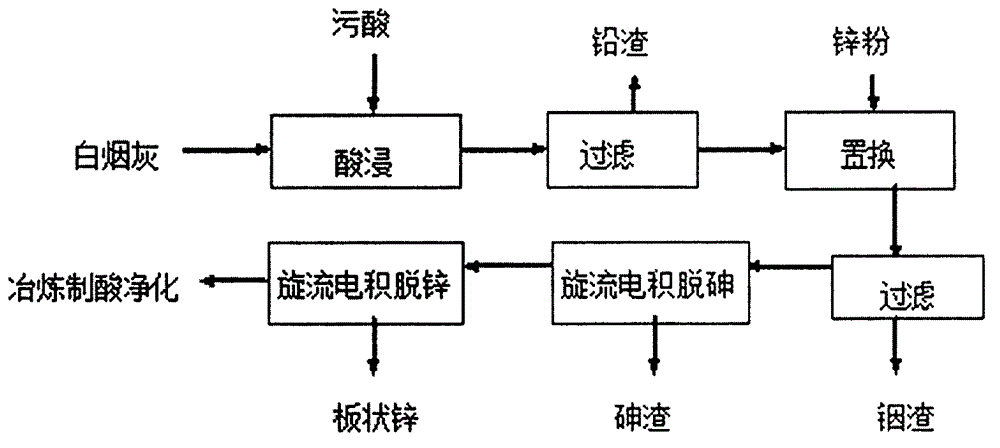Method of recycling valuable metals from arsenic-containing soot
A technology for valuable metals and soot, which is applied in the field of recovery of valuable metals from arsenic-containing soot, can solve the problems of land occupation, environmental pollution, etc., and achieve the effects of short process flow, small footprint and simple operation
- Summary
- Abstract
- Description
- Claims
- Application Information
AI Technical Summary
Problems solved by technology
Method used
Image
Examples
Embodiment 1
[0014] The dirty acid used in this example is lead smelting dirty acid, and the specific components are shown in Table 1; the white soot is copper smelting soot, and the specific components are shown in Table 2.
[0015] (1) The dirty acid and white soot are mixed according to the liquid-solid ratio of 5:1, the pH value is controlled at 2.5-3.0, and 500ml is taken for acid leaching at a temperature of 70°C for 2 hours. Filter to obtain leachate and lead slag. After testing, the leaching solution was 380ml, the lead slag was 78.8g, the leaching rate of As was 95.4%, the leaching rate of Zn was 83.1%, and the leaching rate of Pb was only 2.34%. The specific leaching data are shown in Table 3;
[0016] (2) the leaching solution is replaced with zinc powder for indium, and filtered to obtain indium slag;
[0017] (3) The filtrate was de-arsenized and de-zincified by cyclone electrowinning, and arsenic slag and zinc slag were recovered. The de-arsenic rate was 99.2%, and the de-zi...
Embodiment 2
[0029] The dirty acid used in this example is zinc smelting dirty acid, and the specific components are shown in Table 5; the white soot is copper smelting soot, and the specific components are shown in Table 6.
[0030] (1) The dirty acid and white soot are mixed according to the liquid-solid ratio of 5:1, the pH value is controlled at 2.5-3.0, and 500ml is taken for acid leaching at a temperature of 80°C for 2 hours. Filter to obtain leachate and lead slag. After testing, the leaching rate of As was 95.7%, the leaching rate of Zn was 82.8%, and the leaching rate of Pb was only 2.37%. The specific leaching data are shown in Table 7;
[0031] (2) the leaching solution is replaced with zinc powder for indium, and filtered to obtain indium slag;
[0032] (3) The filtrate was de-arsenized and de-zincified by cyclone electrowinning, and arsenic slag and zinc slag were recovered. The de-arsenic rate was 99.1%, and the de-zinc rate was 58.9%. The specific data are shown in Table 8....
PUM
 Login to View More
Login to View More Abstract
Description
Claims
Application Information
 Login to View More
Login to View More - R&D
- Intellectual Property
- Life Sciences
- Materials
- Tech Scout
- Unparalleled Data Quality
- Higher Quality Content
- 60% Fewer Hallucinations
Browse by: Latest US Patents, China's latest patents, Technical Efficacy Thesaurus, Application Domain, Technology Topic, Popular Technical Reports.
© 2025 PatSnap. All rights reserved.Legal|Privacy policy|Modern Slavery Act Transparency Statement|Sitemap|About US| Contact US: help@patsnap.com



